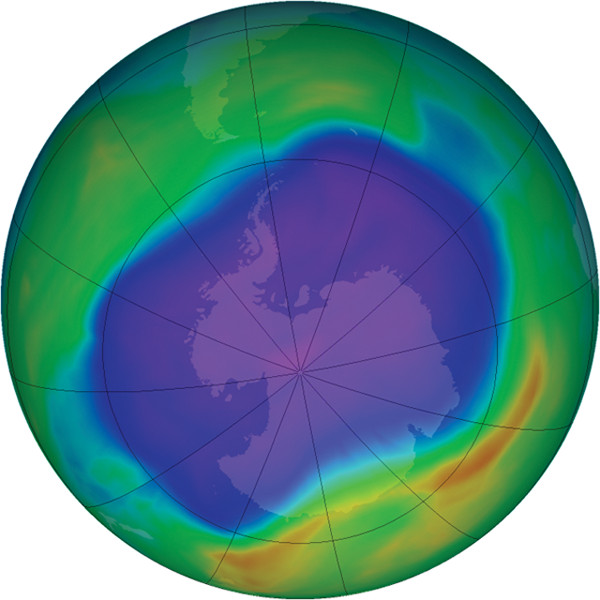
by Timothy Oleson Tuesday, November 4, 2014

The ozone hole (purple and blue) over Antarctica, visualized from satellite data, reached its greatest extent in 2006. Levels of ozone-depleting chemicals in the atmosphere have been declining overall in the last 10 to 15 years, although carbon tetrachloride has not dropped off as rapidly as expected. Credit: NASA.
Earth’s ultraviolet light-shielding ozone layer is recovering, according to a report released in September by the World Meteorological Organization and the United Nations Environment Programme. The findings, authored by more than 250 scientists and presented as part of the latest Scientific Assessment of Ozone Depletion (SAOD), suggest the ongoing success of the 1987 Montreal Protocol and its amendments in cutting atmospheric levels of chlorofluorocarbons (CFCs) and other ozone-depleting substances (ODS’s), which have fallen by about 10 to 15 percent overall since peaking in the late 1990s.
Not all ODS’s are dissipating as fast as expected, however, and “gaps in understanding remain,” the report noted, “particularly for carbon tetrachloride.” But a new modeling study in Geophysical Research Letters (GRL), published too late to be included in the larger assessment, is narrowing this gap.
Carbon tetrachloride, or “carbon tet,” was once used in fire extinguishers and as a cleaning agent, before emissions were banned by developed and developing countries in 1996 and 2010, respectively, by amendments to the Montreal Protocol. (As of 2008, though, it was still the third-most abundant ODS behind two CFCs.) Based on near-zero reported emissions between 2007 and 2012 and an estimated atmospheric lifetime of about 26 years, scientists have figured that carbon tet concentrations in the atmosphere should have dropped 4 percent annually in recent years. Yet, atmospheric measurements have shown it decreasing by only 1 percent on average, suggesting the gas is still being emitted, slowing regeneration of ozone and contributing to greenhouse warming.
“Basically, [carbon tet] emissions reported by all countries do not match up with the rate at which the concentrations are falling off, and with our original understanding of its lifetime” in the atmosphere, says Qing Liang, an atmospheric scientist at NASA’s Goddard Space Flight Center and lead author of the GRL study.
This inconsistency has been recognized since the late 2000s, Liang says, but sorting it out — whether it’s due to misunderstandings about rogue emissions or about the lifetime of carbon tet — has been complicated by several factors. For one thing, unreported and unknown emissions sources aren’t easy to identify or quantify. Also, compared to CFCs, the life spans of which are better established, the life span of carbon tet in the atmosphere is not well constrained.
“The removal process for CFCs happens almost purely in the atmosphere through photolysis” and other chemical reactions that are relatively well understood, Liang says. Carbon tet, meanwhile, is also removed from the atmosphere by the ocean and soil, “and the loss associated with these two [sinks] has much larger uncertainty compared to the loss associated with atmospheric photolysis,” she says.
Liang and her colleagues worked around this issue in their modeling by factoring in estimates of the fraction of carbon tet emissions originating in the Northern versus Southern hemispheres, available from pre-Montreal Protocol data and more recent data on emissions of other ODS’s. This allowed them to establish a concentration gradient between the hemispheres. Combined with the atmospheric measurements, the researchers then came up with quantitative estimates of unreported global emissions and of the lifetime of carbon tet.
Both of their estimates, it turned out, differed from scientists’ best approximations to date. The team’s modeling suggests that an average of 39 kilotons of carbon tet still escape into the air unreported each year, lower than the estimate of 57 kilotons per year offered in the recent SAOD. On the other hand, they reported, the gas likely remains in the atmosphere longer than thought — closer to 35 years instead of 26 years.
The discrepancies related to carbon tet levels are “one of the bigger riddles right now in the business,” says Ray Weiss, an atmospheric chemist at the Scripps Institution of Oceanography and co-head of the Advanced Global Atmospheric Gases Experiment, a worldwide atmospheric monitoring network. This study offers “an interesting statistical analysis” and “contributes to the understanding of the discrepancies,” Weiss says.
With better estimates of total unreported emissions now in hand, Liang says, the next step is honing in on the emissions’ unknown sources. Carbon tet could be leaking unwittingly, for example, from landfills, from contaminated sites where it was once used, or from industrial plants where it is still used legally as a feedstock in the production of other chemicals. Or emissions produced surreptitiously could simply be going unreported.
With existing information, Liang says she thinks “we can still tease out which regions … the emissions are from, and whether the emissions pattern has changed with respect to the previous years.” And of course, Weiss adds, having additional stations around the world taking more frequent measurements could also help locate potential sources.
© 2008-2021. All rights reserved. Any copying, redistribution or retransmission of any of the contents of this service without the expressed written permission of the American Geosciences Institute is expressly prohibited. Click here for all copyright requests.